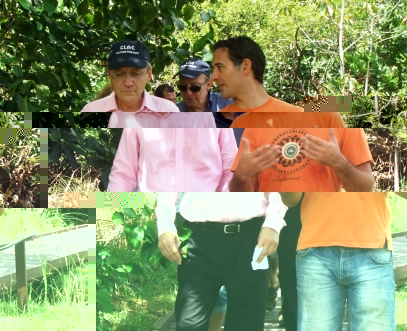Francophonie DG visits Nature Seychelles |02 March 2013

Mr Duhaime was taken on a tour of both facilities by Nature Seychelles staff who included director Kerstin Henri, projects coordinator Martin Varley, and Robin Hanson, green health coordinator Robin Hanson.
Mr Duhaime was particularly delighted by his visit to the Heritage Garden, which showcases plants important to Seychelles, its culture and traditions.
Nature Seychelles’ staff who helped shape the garden to what it is today had a lively discussion with the director general about the garden, its purpose and the different plants found there.
The garden is a demonstration of medicinal, herbal, food and endemic plants that are important to Seychelles, but are in danger of disappearing. It has inspired other gardens in local schools and in the community. Various local and international organisations, businesses, government, foreign delegations, and people from all segments of society have visited, with staff serving as guides.
The aromatic and medicinal plants were of great interest to the visitors as were local fruits used in local cuisine. Mr Duhaime was shown the endemic plants of Seychelles such as Koko Maron (Curculigo sechellensis) which was used to make ropes and brooms.
It was explained that the garden is one hundred percent organic and no chemicals are used either for growing or to control pests.
At the Sanctuary at Roche Caiman, Mrs Henri related the history of this man-made urban wetland in the proximity of Victoria. The wetland resulted from reclamation work done in the East Coast of Mahé in the 1980s. Lagoons at the site became an important site for birds, especially waders, soon after their creation.
Nature Seychelles started managing the site in 2002 and has developed it into a learning area by restoring and creating new habitats. It created features like open water areas, improved and created new ditches and wader pools for birds. A boardwalk and a bird hide made from recycled Coca Cola bottles was also built so all visitors could have an enjoyable visit to this unique little wetland.
Besides offering a natural retreat, the wetland is also now an area for restoring health and well-being through the Green Health programme. This involves a weekly programme of yoga and green exercise for participants, particularly those who are most vulnerable in society.
An area of the Sanctuary where local species of mangroves grow is being enhanced, Mr Duhaime heard. Mangroves are essential coastal habitats for building natural resistance to climate change. This area will be used as a demonstration site to explain how mangroves work.




